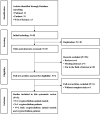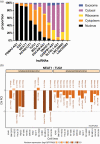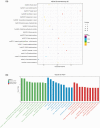Exploring dysregulated miRNAs in cryptorchidism: a systematic review
- PMID: 33729892
- PMCID: PMC7975578
- DOI: 10.1177/0300060521999950
Exploring dysregulated miRNAs in cryptorchidism: a systematic review
Abstract
Objective: To identify dysregulated miRNAs in testicular tissues from animal models and patients with cryptorchidism.
Methods: Databases were systematically searched for studies published before 10 May 2020 that had investigated miRNAs in cryptorchidism. Predicted targets of the identified miRNA biomarkers were obtained by searching TargetScan and Starbase. Gene ontology (GO) and Kyoto Encyclopaedia of Genes and Genomes (KEGG) pathway enrichment analyses were subsequently conducted.
Results: Five publications met the eligibility criteria for the review. 21 differentially expressed miRNAs were the most abundantly reported in 185 animal and human tissue samples. Three miRNAs (miR-210, miR-449a and miR-34c) were dysregulated in both animal and human testicular tissues. The top five relevant lncRNAs associated with the miRNAs were NEAT1, KCNQ1OT1, XIST, AC005154.1, and TUG1.
Conclusions: Further research is warranted to explore the potential of these dysregulated miRNAs as biomarkers or therapeutic targets for male infertility associated with cryptorchidism.
Keywords: Cryptorchidism; biomarkers; miRNA; systematic review.
Conflict of interest statement
Figures





References
-
- Radmayr C. Management of undescended testes: European Association of Urology/European Society for Paediatric Urology guidelines. J Pediatr Urol 2017; 13: 550. - PubMed
-
- Sijstermans K, Hack WW, Meijer RW, et al.. The frequency of undescended testis from birth to adulthood: a review. Int J Androl 2008; 31: 1–11. - PubMed
-
- Kolon TF, Herndon CD, Baker LA, et al.. Evaluation and treatment of cryptorchidism: AUA guideline. J Urol 2014; 192: 337–345. - PubMed
-
- Docampo MJ, Hadziselimovic F. Molecular Pathology of Cryptorchidism-Induced Infertility. Sex Dev 2015; 9: 269–278. - PubMed
-
- Virtanen HE, Toppari J. Cryptorchidism and Fertility. Endocrinol Metab Clin North Am 2015; 44: 751–760. - PubMed
Publication types
MeSH terms
Substances
LinkOut - more resources
Full Text Sources
Other Literature Sources
Miscellaneous

